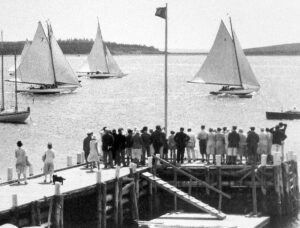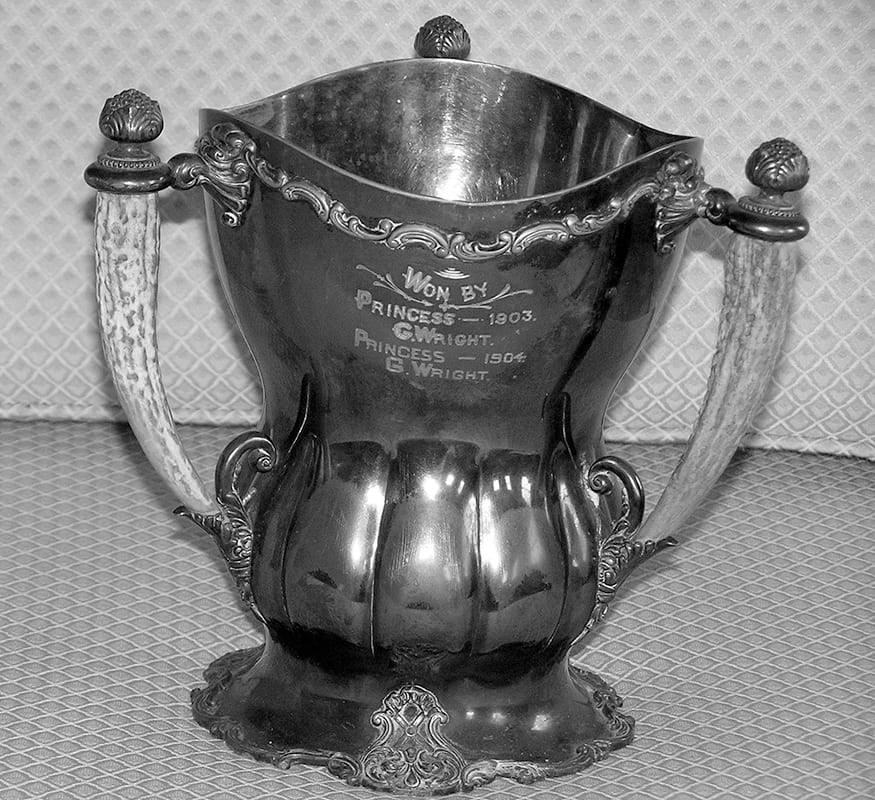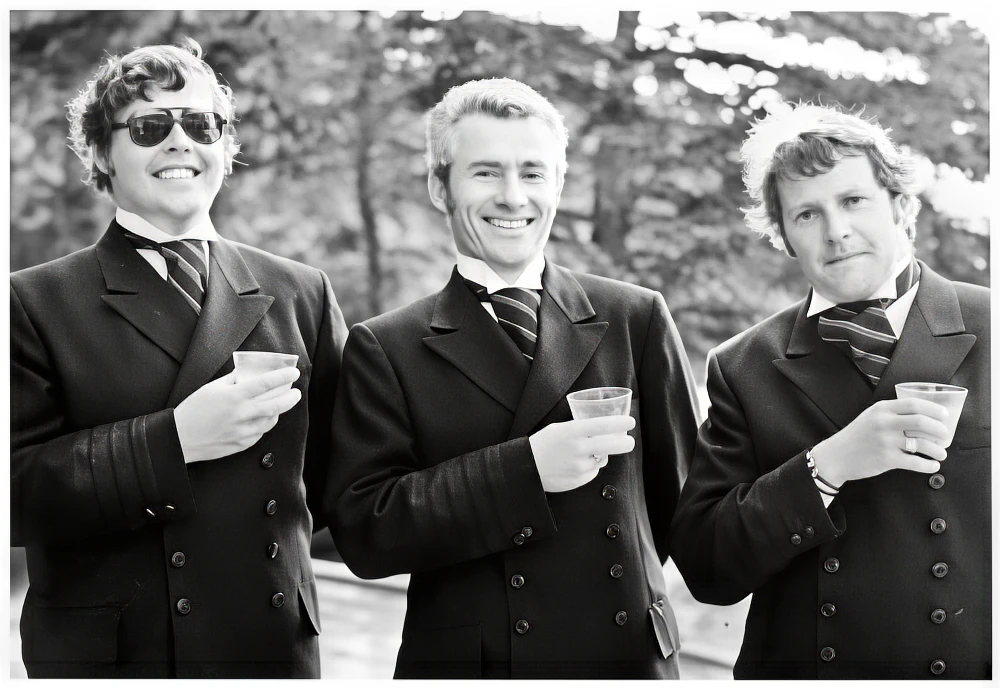Since the sea gives Chester its character, sailing naturally occupies a position of importance here. Yacht racing has been a major summer sport in Chester for well over 150 years. Its roots are firmly planted in the mid-19th century when the fishermen raced each other to markets in Halifax or New England.

As sailors and fishermen have been wont to do since time immemorial, they loved to get together and talk shop. Sailing races for pleasure and bragging rights were inevitable. As the gatherings and races occurred more regularly, the Annual Fishermen’s Regatta was born. The regatta was a showcase for locally built boats of different designs and sailing skills.
The first documented regatta was in 1856. It is reported to have been attended by 3,000 people who participated in a parade, amusements, and races on land as well as the sea. In 1858, a rowing race for ladies was added, and a dance took place at the Mulgrave Inn, which had been hosting guests from Europe, the US and Canada since 1820. In 1860, the press reported the regatta pleasures were “enhanced by a large party consisting of 150, accompanied by the city band, who arrived in the steamer ‘Neptune’ from Halifax”.
In 1885, the two-day regatta had boats from Mahone Bay, Lunenburg and the two Tancook islands. The big excitement was a circus that featured a hand-cranked Ferris wheel on the parade ground. According to the Lunenburg newspaper, the 1888 Annual Regatta attracted 2,000 spectators who were treated to “the closest and most exciting match of its kind ever witnessed in the South Shore.”
After Chester Yacht Club was established in 1902, it became the focal point for racing. Charter member Ned Fader remembers, “Citizens donated prizes: 100 pounds of sugar, a barrel of flour, maybe a little cash. A boat crew could get a wonderful view on life for a dollar … best of ale, fifty cents a gallon, good rum at one dollar a quart. They were all good God-fearing people, but they did not let it spoil their lives too much.”
In 1902, there were five classes for racing yachts based on the old Rater Rule (waterline and sail area). As interest increased and designs evolved, competitive requirements led to more classes, designs and sizes. And so it shall always be.
A 1903 Hackmatack Inn brochure claims that during Regatta Week, the competition attracted boats from Halifax, Yarmouth, Sydney, and Digby yacht clubs. The annual cruise to Chester enhanced the fun of racing.
For a few years, the race starting line was in the Front Harbour, but that soon proved too narrow. It was moved to the Back Harbour, where it remained until 1926 when CYC acquired the present Club House and wharf.
There were slow years during World War I, but the Twenties were years of great Chester racing successes. The competition between Chester yachts and those of the Royal Nova Scotia Yacht Squadron (RNSYS) was intense, and it continued throughout the Depression and the rest of the Thirties.
The World War II years closed RNSYS and seriously disrupted Chester Yacht Club, with decreased membership and funds. The Club stayed open, but big yachts and men were mostly absent. The rationing of fuel and other necessities limited provincial travel.
By 1945, folks were returning to Chester and inter-club racing. Chester yachts cruised to Halifax for their big open cup competition. RNSYS returned the favour by accompanying the yachts back home. For the first time since the turn of the 20th century, four clubs were competing in Regatta Week. Yachts from Bedford and the newly formed Armdale Yacht Club joined RNSYS. The competition was keen. The Visitors’ Cup was won by a Halifax skipper in “Restless,” one of the Heisler Chester C’s. Chester continued winning most of the trophies.
The difficulties of two world wars and a major depression had left their mark, and by the 1950s, Regatta Week had diminished considerably. The Members were keen to restore the fun of a “Race” Week. They enthusiastically and successfully promoted the big Race Week regatta. More yachtsmen from LaHave, Lunenburg, and the two Halifax Clubs participated.
The Chester Yacht Club was finally granted a liquor license in 1952. In 1955, the visiting yachtsmen for Race Week were entertained in the homes of 20 club members or at their cost. There should have been less need to entertain at members’ respective homes, but the greater clubhouse entertaining was demanding of volunteer contributions of time and material. Cooks and bartenders were hired.

An annual cruise to Lunenburg had been a regular event since before the Lunenburg Yacht Club was officially established in 1948. Now called the Prince’s Inlet Race, it was becoming a major celebration at the end of Race Week. This consisted of a morning race from Lunenburg followed by a race of the entire Race Week fleet back to Lunenburg.
In the early Fifties, there were between 15 and 25 participants, but by the end of the decade, the average participation had mushroomed to 40.
By the Sixties, change was the rule of the day. As wooden boats disappeared, the number of fibreglass boats grew. Racecourses, rating systems, trophies and classes of racing yachts changed. The former First class was divided into A1 and A2. The second class became B, and the Third became C. As usual, Race Week was the highlight of the racing season, and the racing committee was keen to increase participation.
In 1964 after much deliberation and consultation with local racers as well as with those from other clubs, Chester Race week was fixed for the third week of August, all boats were in the water by then and crew availability was good. This event would make Race Week even more attractive to local and visiting sailors. That year, enhanced by the perfect weather, at least 16 boats crossed the line for every race. The previous year, the most valuable trophies had been contested by no more than three boats. Three years later, as part of the 1967 Centennial celebrations, Race Week was held in July, which was a disaster. A July Race Week will definitely not happen again for another hundred years!
The 1970s began with Race Week at a low ebb. The Executive embarked upon a major rejuvenation program. Promotion efforts included letters and personal contacts with other yacht clubs and sailors. In 1972, the Executives of Lunenburg and Chester clubs made a special effort to bring back the Prince’s Inlet race. They succeeded: greater numbers registered and much fun was had by all.

In the past, most post-race entertainment had been private parties on boats or homes. Now, parties and dances were held at the Club House. The number of drinks that were dispensed through a small window on the back wall of the Club House was mind-boggling.
In 1973, the official end of Race Week was on Wednesday, but by popular request, a handicap race was held on Thursday, along with a ‘rum run’ to the Lunenburg Yacht Club on Friday, with yachts competing for the coveted “liquid trophy.” This was to encourage as many boats as possible to go to LYC for the race back to Chester on Saturday morning, but not before a hearty LYC breakfast! Seventy-eight yachts raced back to CYC that afternoon!
By 1975, an unprecedented 115 yachts started, and 108 finished. Chester Yacht Club served food to 400 people, and Lunenburg organized Prince’s Inlet race day. Many food items arrived directly from members’ kitchens.
Although participation in Club races was disappointing, Race Week kept growing with good fleets in all areas, including the major cup races. The larger Universal-rated and CCA cruisers were being replaced by the smaller fibreglass handicap racing boats. In 1973, the Solings had their own class, and a Junior Regatta was part of the festivities. Handicap races in 1974 included 10 to 16 boats each, and up to 10 competed for the big cups. In 1975, racing boats paid a $5 registration fee to defray expenses, such as boats rented for the gun and ferry services. Coffee, donuts, hot dogs, and sandwiches were available at the Club House, with the proceeds going to the juniors, who had done much of the work involved.
By the mid-seventies, Race Week was getting increasingly complicated. The Rear Commodore, whose duties included organizing the regatta, required the patience of Jobe to be all things to all people. During this period, the task of Rear Commodore fell upon the shoulders of a highly respected clergyman sailor. In the middle of race week fracas, one sailor innocently asked him how things were going. Patience wearing thin, he announced in more sailor-like than ecclesiastic language that things were indeed “going as normal, all …. up”. Witnesses still tell the story with joyful reverence.
One Rear Commodore characteristically reacted to the high stress by pacing and scratching his head. After one particularly bad day, while problem-solving on the wharf he paced and scratched his way right off the edge of the wharf — backwards. His rescue was more hilarious than anxious. At a later date, the Juniors who had witnessed the event presented the situation to the members in a memorable skit.
By 1976, the Club was really stretched trying to accommodate the large number of people participating in Race Week. Although limiting entries was considered, the financial boost and the reputation of Chester Yacht Club as the friendliest club in the area prevailed. In an attempt to simplify administration, a special Race Week committee was organized with the Rear Commodore as chairman. A Prince’s Inlet registration fee of $10 was added to the $5 general registration fee.
Another attempt at greater efficiency in working out race results came in the form of a donation of a 400lb computer. Launched into the computer age, members were happy to heave and push this great machine up to the third floor. Unfortunately, the fog and dampness of the summer “upset its innards, and it could no longer remember what it was supposed to.” According to the Rear Commodore, it was ceremoniously taken out behind Tancook and “given the deep six.”
Executive members met with their colleagues from other yacht clubs to coordinate schedules, and Race Week ’76 was a significant success with 65 yachts registered. Chester land spectators were rewarded by the sight of 75 spinnakers arriving at the finish line from Lunenburg for the morning leg of Prince’s Inlet race. That afternoon, 115 registered yachts started the race to Lunenburg. The spectator fleet consisted of 20 to 30 boats. Regardless of all the great success and hoopla, the grand finale of Princes Inlet collapsed on a beautiful, sunny, but breeze-less day! The legendary partying met expectations. After this very successful Race Week, the Handicap fleet, which had experienced spectacular growth, was split into Class A and Class B. The Rear Commodore suggested that the regatta be limited to 65 boats, with preference given to boats having participated in previous Race Weeks.
The middle 1970s were years of imaginative and energetic leadership at Chester Yacht Club. Significant advances resulted in all areas, especially the Junior program and Race Week (even with a near-nil bank balance). Chester Race Week was the only race week left in the province, and the members felt that it was important not only for the Club but also for the province. It was growing, and its good reputation was spreading. Sailors from all around the province had an arena where they could test their skills. Furthermore, this was the only venue where the old Universals could gather and compete as they had in the past.
In the evenings, sailors loved to re-race the day’s events over a brew or two while perching on the railing around the clubhouse verandah. Some occasionally may have stayed too long and indulged in too many brews. One evening, an intrepid fellow holding aloft a large bottle of lady’s perfume equipped with an atomizer ran along the verandah. The railing cleared in a heartbeat. Arriving home reeking of perfume was not in these sailors’ plans.
The number of participants kept growing. Fleets of 100 or more boats were racing daily. There were 125 for Prince’s Inlet in 1977 and 120 boats in ’79. Valuable suggestions for improvements surfaced: security measures, a paid person to run the races, and a permanent Protest Committee. A skipper unhappy with a Race Committee decision had cut free one of the rented race markers near the yacht club. The members barred him from anything pertaining to the club for one year. A committee was formed to study and implement means of improving Race Week.
The 1980s began with at least one merciful improvement: crews were offered the use of portable showers and toilets (Johnnies-on-the-Spot.) There must have been a noticeable decrease in summer business for Chester plumbers! Cleaning up the grounds was a big issue with which the Juniors were a great help. That year, Race Week had 108 boats registered, with 171 for Prince’s Inlet. Discussions about improving the tabulation of race results continued. The memory of the failed computer project remained, but computer assistance was becoming more attainable. A simple means of increasing registration efficiency had been attempted by sending registration forms to other clubs three weeks before Race Week. Only 40 were returned.
Two representatives of the Nova Scotia Sailing Association received an honorarium for helping with race results. With a minimum of 6 yachts necessary to start a class, there were classes for IOR, Universal, Handicap A & B, and One Design (Soling, Etchells 22, J24, Kirby 25 and Roué 20). Schooners and planing hull boats were not allowed to race. Events were for the whole week, starting Sunday with the Outer Island Race. Fridays were for any postponed races, and Saturday was Prince’s Inlet. Any yacht wishing to enter a protest had to pay a $10 fee to the Race Committee before the protest could be heard. A successful protest refunded the fee.
The 1981 notices sent to all Clubs announced a $5 reduction in fees for early registration. The result was minimal, but registration was down due to the Marblehead Race. Registration was now $5 to $35, depending upon the yacht. Insurance coverage was compulsory, and all yachts had to be registered. Apparently, some past race participants had merely shown up. 1984 had a major sponsor — Olands Light Beer. Daily evening social events at the clubhouse were added to lunches. Participants and friends enjoyed chilli dinners, chicken barbecue, pizza, and Olands’ steer barbecue, followed by dancing with a live band.

By the mid-1980s, up to 30 boats were from Lunenburg alone. They had been hosting Prince’s Inlet race since 1951, and a great rivalry was growing between Chester and Lunenburg. By 1986, racing classes, which had to have at least eight boats, included a handicap C, and competitors raced for 21 trophies.
By the end of the 1980s, Lunenburg’s Prince’s Inlet cruising race was extremely popular. The racing fleet averaged 100 participants. Hundreds of spectators on land and sea were thrilled to see the starts and finishes, especially that of the fleet racing through the narrow passage of Indian Point. Concerns about safety and liability, however, eventually led to the race’s demise in the early 1990s. The beauty of all those spinnakers flying over the horizon is a real loss.
Now, well into the new millennium, Chester Race Week continues with a slightly shorter week but with unabated success. Clubs from all over the Maritimes and New England are regular competitors. Small boats, especially Bluenoses, have a considerable presence. Larger boats have their own starting line and form a small cruising class. Classic designs are being revived. Each year, several one-design classes are added to the handicap classes. Professional judges and race organizers run the races with Chester Yacht Club volunteers. Evening entertainment includes dinner and live music every night, and afternoon events are organized for the sailors’ friends and family.
And the computer? Well, it is now the central engine that keeps up to 150 competitors organized and aware of their standings almost as soon as the last boat crosses the line.
Chester Race Week, still held during the third week of August, is a boisterous, busy time. Now billed as “Canada’s largest keelboat regatta,” Race Week offers an unsurpassed racing venue. Nova Scotia professional sailors have proclaimed it the best in the world — as long as the weather cooperates, of course! Hundreds of participants and spectators enjoy the races and the on-shore entertainment, and sailors from all over Canada and the States now attend every year. As you’ll often hear from Race Week veterans, once you’ve experienced Chester Race Week, it won’t be your last!